Case Report
The Evolution of Agri-Tourism practices in India: Some Success Stories
1Freelance Researcher, India
2Professor, Institute of Rural Management, Gujarat, India
*Corresponding author: M V Durga Prasad, Professor, Institute of Rural Management, Gujarat, India, E-mail: dprasad@irma.ac.in
Received: December 12, 2018 Accepted: January 17, 2019 Published: January 23, 2019
Citation: Chatterjee S, Prasad DMV. The Evolution of Agri-Tourism practices in India: Some Success Stories. Madridge J Agric Environ Sci. 2019; 1(1): 19-25. doi: 10.18689/mjaes-1000104
Copyright: © 2019 The Author(s). This work is licensed under a Creative Commons Attribution 4.0 International License, which permits unrestricted use, distribution, and reproduction in any medium, provided the original work is properly cited.
Abstract
Agriculture and its allied activities are on the brink of a change for both the farmers as well as consumers. A plethora of diversified activities amalgamated with scientific methods of cropping are paving a way for a mechanized and secure future. Farm visits, farm stays and trail visits are gradually picking up amongst tourists to experience something different from clichéd sightseeing packages of a destination.
The paper focuses on cases of various successful farms from India and integrates them to analyze the sustainability factors in the farms. The paper delves deeper into the short cases and the methodology adopted would be qualitative in nature. Structured and unstructured interviews shall be conducted for the case protagonists and staff for acquiring a synthesis of the theories and the farm practices. Research limitations shall be the fact that all such farms cannot be visited owing to the reasons of difficult terrain and scarcity of time.
This paper as an exemplary can help to achieve many other success stories. Agritourism with its baby steps and the talisman of research can definitely bring changes in the life of farmers and consumers shall also reap the benefits of it.
Keywords: Agri-tourism; Case-research; Farm-visits; Local communities; Additional income.
Introduction
Agriculture is considered to be the backbone of the Indian economy. Around 85 percent of the population is directly or indirectly dependent on agriculture and allied activities and almost 26 percent of India's GDP comes from agriculture. 90 million farmers are dwelling in 0.625 million villages producing more than 20 Metric Tonnes (MT) of food grains feeding the country. More than a profession or a business, agriculture is deeply rooted in the Indian culture. Farmers are now enthusiastic to try newer methods away from the typified and orthodox patterns to build relations with the consumers directly and earn extra. Hence, adding on to the agricultural income with some touristic activities is bringing in new hopes and better lives. Serious efforts are now being made in this direction and Agri-Tourism is one such activity that fits the bill. Agri-tourism as a concept is not very new although its reach is limited to only some places. Agri-tourism with its baby steps and the talisman of research can definitely bring changes in the life of farmers and consumers shall also reap the benefits of it.
The concept is considered as a supplementary to the primary source of income and caters to a niche market due to its exclusivity. The idea has a novelty attached to it in terms of nostalgia as well as village visits for consumers. A plethora of diversified activities amalgamated with scientific methods of cropping are paving a way for a mechanized and secure future. The plate is full with offerings like dairy practices, bird watching, wine trails, hay making and local handicrafts to woo the consumers with the simplicity of villagers hooked to it in the background. Promotion of Agri-Tourism involves some more important stakeholders namely Ministry of Agriculture and line departments at state and central governments and farmers. Promotion of Agri-Tourism needs conceptual convergence with Rural Tourism, Eco-Tourism, Health Tourism, Adventure Tourism and culinary adventures. Research is one of the key factors for development in any discipline as it helps students and practitioners to get involved in their areas of interest and search for all possible solutions for the benefit of local issues and communities.
The paper delves deeper into the short cases from all the corners of the country. The fresh smell of the wet soil, the fresh air wafting through the hair and the chirping of the birds in a majestic surrounding make us fall in love with the nature and attracts the urban tourists trying to get away from their regular hectic schedule. The consumers are ready to pay any amount to book a bullock cart rides, learn pottery or beadwork which are offered as activities at ATDC in Baramati near Pune in Maharashtra. ATDC is working hard for the farmers of the nearby area to find means of augmenting their income. The consumers as tourists also look forward to engage with the local traditions, food, culture and festivals. There are special camps coming up to experience the full moon night and watching the pristine sky full of stars. The latest trend catching up is of taking a walk in the vineyards and picking up farm fresh produces. The consumers visiting farms also look to purchase the local handicrafts and souvenirs that they like to keep as a memento of their sojourns in the rural hinterland. The changing trends in this field are opening many avenues for exploration. The cattle fairs like the Sonpurmela in the eastern fringes of the country which catered to the cattle owners previously now attract tourists from other parts of India and also from abroad. The annual flower festival of Sikkim in the northern part of the country is another example where tourists throng to see the vast flower farms and even participate in the contests happening in the festival. Temples in India are another melting pot of various tourists owing to the spiritual roots of the country. A temple located in the western zone of the country specializes in Temple tourism where in devotees buy fresh vegetables and fruits born by the farms in the temple premises as offerings to the deities. So in an Indian context the agri-tourism definition stands on the following grounds (Figure 1).
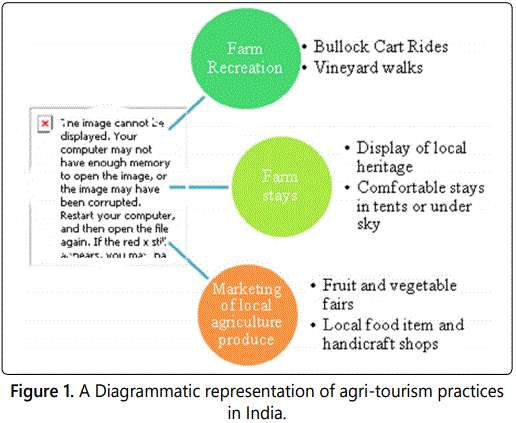
The power to implement is extremely important in India as it has a huge area of cultivable land which needs to be harvested as well as infrastructure strong to support agritourism practices. The following modeling (Figure 2) depicts as to how the network diagram the research wants to develop for the farmers for an all round year approach to touristic activities. Powerful ideas were generated for newer methods and innovations to attract tourists like orchard stays, floral tours, picking of fresh fruits and vegetables as activities coupled with implementation. Along with trying of new ideas and marketing of those ideas the impact also needs to be checked that will prompt more tourists to come in as well as sustainable growth to the farmers. This shall be a cyclic process to be the key to success.
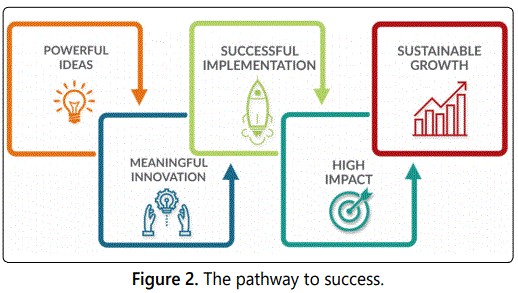
The success stories from different geographical locations of the country reflect the idea of how marketing of the farms interspersed with tourism services are able to help in the transformation of the lives of the farmers as well as tourists. It is a two way process where both the parties are engaged as well as share a symbiotic relationship. With greater inflow of tourists all the year round the farmers; the ones providing the land, accommodation facilities and visual experiences get the lion share in this win-win situation (Figure 3). The expected results from the amalgamation of the farm visits with the theoretical support shall lead us to prepare a framework as illustrated in figure 2 which shall pave way for other farmers to adopt agri-tourism practices. The expected results should be able to herald a secure future in terms of continuous flow of cash during the slump agricultural seasons where tourism activities shall take care of the farmers and tourists. The paper also looks into the sparsely available literature in this domain and shall attempt to comprehensively build upon a model for replication in the area of similar soil and climatic conditions. The methodology shall leave the scope open for mixed techniques if required.
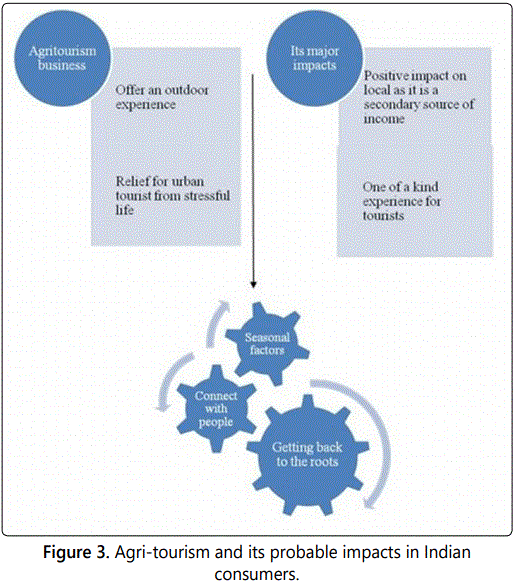
The seasonal factors like rain patterns, harvest seasons attract bunch of tourists to return to their homeland and take part in the various festivities and hence add on to the scope for marketing to open the doors for rural visits or farm stays. The local communities follow their spread of customs and prayers for a good agricultural harvest season and seek the blessings of their ancestors. They also involve a lot of indigenous practices that they pass on to the next generations and thereby conserve their traditions and practices. Hence in the garb of business agri-tourism offer a quick relief from the mundane regular life of the urban population as well as an outdoor experience within the reach and budget. Tourists get the home feeling as well as the human touch with agri-tourism practices. The probable impacts that can be gauged will be one of an experience for the tourists while the farmers get to supplement their income by just making the farms look beautiful and bountiful. This income for farmer will also provide a partial contribution in India's Prime Minister's vision of doubling income of farmer by 2022.
The Literature Review
As Shembekar [1] points that, “There needs to be a proper business model to promote and propagate the concept of agri-tourism as an easily adoptable and implementable venture for farmers in India. All challenges that researchers face can have solutions and agri-tourism can be ventured in gradually step by step. All depends on the will power of farmers and proper promotional strategies adopted to market the concept in weekend tourists”.
As Shembekar [2] pointed that “Agri-tourism as a concept does not have a concrete literature which encompasses the entire scope of it from a holistic point of view (Figure 4). Rather there are more specific studies which are either region specific or enlighten a particular part of it such as agri-tourism destinations or agri-tourism in a particular place such as a district in Rajasthan or Punjab. When it comes to Indian contexts, majority of literature seems to concentrate around the agritourism operations in western belt of Maharashtra and the activities of Agri Tourism Development Corporation (ATDC).” There are many other notable definitions out of which few are as stated here. “It is an enterprise at a working farm conducted for the enjoyment of visitors that generates income for the owner” [3]. “Innovative agricultural activity related to tourism and agriculture both which has capacity to create additional source of income and employment opportunities to the farmers and local communities” [4]. “Agri-tourism is a type of rural tourism in which the hosting house must be incorporated in to an agricultural estate allowing visitors to participate in agricultural activities” [5]. “It is the action of hospitality carried out by agricultural entrepreneurs that must remain connected to farming activities” [6]. Maetzold defined Agri-tourism as an alternative enterprise, “It is a set of activities that occur when people link travel with products, services and experiences of agriculture” [7]. The whole concept shall take into account the whole experiences of a tourist because of the destination.
Agri-tourism is specifically defined by Man has as “travel which combines agricultural or rural settings with products of agricultural operations, all within a tourism experience or a range of activities, services and amenities provided by farmers”. He also calls it “innovative income generating activity for enterprising farmers” [8]. After considering all view points of researchers, the modified typology for Agri-tourism is proposed by the researcher as in figure 4.
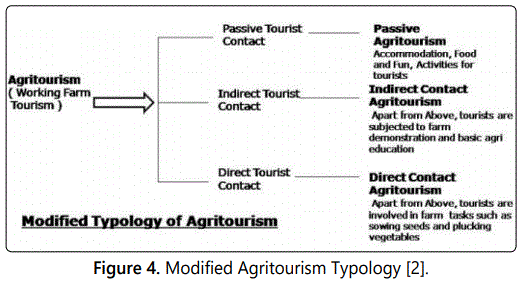
According to Veeck et al. [9] defining agricultural tourism is something akin to the blind men and the elephant, but there is general agreement that agri-tourism incorporates visits to farms for the purposes of on-site retail purchases, enjoyment, and education (cooking classes, flower classes, and farm history among others [10]. Participating farmers hope for significant and steady retail sales, but the components of entertainment and education that are also provided make agri-tourism more than simply a relocation of retail sales to a family farm. Long important in the European Union (EU), agritourism is gaining popularity throughout the United States. Interest has grown as a result of stagnant staple prices, rising farm costs, and growing international competition. Agri-tourism has not spread much across the states of India and is still concentrated in western belt of Maharashtra. Agri-tourism is still a small scale venture and has low impact on macro economy of India [11]. It is slowly growing in some states like Karnataka [12], Punjab [13], Kumar [14] and Rajasthan [15]. Thus, it can be observed that there is a wide scope for the concept to grow in all agricultural states of India as the market is not at all saturated and is in fact virgin in many of the states like Uttar Pradesh, Bihar and Andhra Pradesh which are prominently agri-driven states of India. As suggested by Veeck et al. [9] agriculture has always been an uncertain business. Global trade patterns have changed dramatically in recent decades for all agricultural commodities, including corn, barley, sorghum, rice, wheat, soybeans, cotton, tobacco, fruits, vegetables, essential oils, and other specialty crops such as honey. Philips [16] gave an illustration on the kinds of Agri-tourist activities as in figure 5.
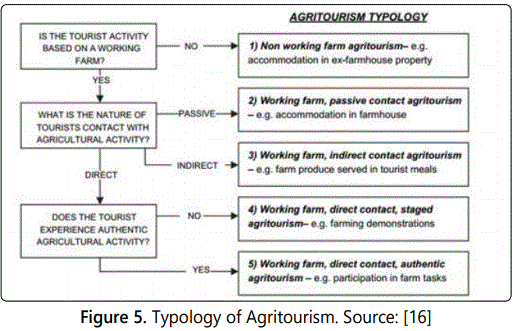
As mentioned by Veeck [9] tourism comes in contact with agricultural activities by visiting a farm where agricultural activities take place and this happens in three different ways: direct contact, indirect contact and passive contact [16]. Agritourism has also been categorized under the category of holiday and day vacations as Malkanthi and Routry [17] mentioned in their paper. Wicks and Merrett [18] further adds that agri-tourism on a small budget can provide fun, entertainment to the visitors with some education on farm activities as well.
Direct contact with agricultural activity indicates that agricultural activities are a tangible feature in the tourist experience (e.g. milking a cow; harvesting a crop). Indirect contact indicates a secondary connection to agricultural activity within the tourist experience, perhaps through contact with agricultural produce (e.g. crop maze, food processing, sale of or consumption in meals). Passive contact with agricultural activity indicates that tourism and agriculture are operated independently and only the farm location is held in common (e.g. outdoor activities). By defining these terms the nature of tourist contact with agricultural activity, and thus the role of agricultural activity in the tourism product, becomes clearer. Agri-tourism has not spread much across the states of India and is still concentrated in western belt of Maharashtra. Agri-tourism is still a small scale venture and has low impact on macro economy of India [11]. As said by Beeton [19], “The case study certainly has a significant place in the exploratory stage of an investigation, but it can also be extrapolated beyond that stage. The application of rigorous interpretation, combined with reason and logic, enables the researcher to obtain place-specific conceptual insights that may then be tested for wider applicability through further case studies or the use of additional methodologies, creating a multi-method case study.” On the other hand the theoretical concepts can be tested against local experiences using a case study [20]. For example, Pearce et al. [21] utilizes case studies to illustrate the aptness of applying social representation theory to different types of tourist settings, using empirical and descriptive appraisals within the case studies themselves.
MacCannell [22], presents a continuum of authenticity in the context of tourist experiences based on the concept of ‘front’ and ‘back’ regions. By thinking of front regions as the stage, where actors or musicians perform for an audience, and back regions as the preparation areas that the general public does not usually get to see, it can be argued that for a tourist to experience authentic agricultural activity they must go ‘back-stage’. Alternatively, tourists can experience ‘staged authenticity’. According to MacCannell's continuum there are varying ways in which authenticity can be staged, from reproduced settings that appear to be authentic (e.g. a model farm) to organized visits that allow tourists a glimpse backstage (e.g. farm tours). One implication of this is that farmer and tourist perceptions of authenticity can potentially be quite different, primarily because their original understanding of agriculture and what it entails is quite different. This also shows how agricultural activities staged by the farmer for tourism may be perceived by tourists as a genuine insight into farming practices. However ultimately an authentic experience of agriculture may only be had by tourists where agricultural activities are practiced as they normally would be. The prospect of tourists experiencing authentic agricultural activity is quite rare and normally involves physical participation in farm tasks. In the majority of cases where tourists have the opportunity to come in direct contact with authentic agricultural activities there will be some element of staging.
A Brief Insight into the Cases
As we all know India is a land of diverse climatic conditions and various terrains from the misty mountains of Meghalaya in the north- east to the white sands of Kutch in the west and from the tulip gardens of Kashmir in the north to coffee plantations of Coorg in the south. The plethora of agri-tourist destinations from all the corners of the country help to give an array of different kinds of entrepreneurial approaches. Some places ride on the bounty of monsoon rains while some showcase breathtaking view of the rocky sand dunes. The cases have been compiled to create a collage of agricultural activities like the spice routes in the states of Kerala and Tamil Nadu, temple tourists in Maharashtra, mustard fields in Rajasthan, emu farming in Uttarakhand, fruits and flower fields in Sikkim. All the cases sashay a common thread of providing tourists a stay in the exclusive view of the farms and purchase of fresh produce. The case studies also round up the purpose of the farmers of choosing agri-tourism as a supplement to their primary activities. The family members of the farmers become the stakeholders and get involved in providing benefits to the tourists. The tourists feel a connect with the nature as well as a part of the tourism activities by enjoying farm lunches, attending fairs, purchase of farm produces and locally produced handicrafts.
North
Starting from the North, a small village nestled in the hills of Kumaon and situated in the Bageshwar district of Uttarakhand there is R.O.S.E (Rural Opportunity for Social Elevation) is working with the agri-tourism model where the tourists can avail homestays amidst the wheat fields and scenic mountain views and indulge in regular work like cooking, harvesting of crops, building of toilets, teaching English to the school kids and many other activities. The latest updates regarding the introduction of new rooms and addition of another washroom with the help of the tourists and volunteers exhibit a great spirit of the owner Mr Jeevan Lal Verma.
East
In the eastern part of the country perched on the rugged terrain of the lower Himalayas in East Sikkim, Zuluk or Dzuluk is a hamlet close to the Indo China border. Located strategically at an altitude of around 3000 meters (10100 ft), it is a relatively new and offbeat tourist destination. A glimpse into the old Silk Route attracts many tourists in this destination and they have a variety of homestays to choose from in Zuluk. Although due to rough terrain and extreme weather conditions there lies no scope for vegetation or cattle rearing. In spite of the myriad conditions residents living in Zuluk have opened homestays for tourists to come and enjoy the taste of Sikkimese hospitality. Montana Homestay is one such example of how villagers reach out to promote their share of goodness along with the bounty of nature. The success of such home stays lie in the fact that one can stay in the natural way and be rooted to the earthiness.
Central
Coming to the central part of the country we have one majestic place named RawlaKaneriya owned by the royal family of Jamnia. At RawlaKaneriya, the Agri-tourism encompasses a variety of activities, including farm tours, farm vacations, farm bed & breakfast accommodations, hiking, nature study, cross country skiing, picnics, hayrides, workshops, fishing and more. The storytelling sessions in the evenings add on to the ethereal experience.
This is a successful case as the linkage between the villagers, tourists and the erstwhile royals work for a common cause.
South
The southern part of the country welcomes all with the fresh smell of grounded spices, cocoanut water, cool climate and a varied cultural mix. Andhra Pradesh Tourism Development Corporation (APTDC) has come up with a unique concept of agri-tourism to promote rural tourism and would be showcasing integrated lush green horticulture farms, dairy, fishing, vegetable poly houses having even guest houses for tourists to stay for a couple of days or more and to get exposure to rural rustic life and natural environment and also to rural eateries reminding one of the days of our grandmothers and fathers. Visits to identified farms in the district would be planned during festivals, weekly fairs involving local festivals and people who are bored going to hill stations and live in air-conditioned facilities will have a very different feel of the enchanting beauties of mother-nature and the rural ambience. The APTDC has identified Adarana Farms in the district to promote the same as an agri-tourism centre along with several other farms in the district. Adarana Farms Chairman Ramakrishna speaking to The Hans India stated that his farm was identified as the first agri-tourism centre which has all the facilities to showcase it as a agriculture rural tourist centre which is an integration of agriculture, horticulture and allied activities including fish farming, goat and sheep rearing, dairy and even fish farming apart from guest houses to accommodate tourists in its lush green 100-acre farm in Rapthadu village in the district.
West
The silhouetted sky and the wide salt deserts wave at us from the western zone of the country with its unique show of the splash of colours and camels in the background. The Shaam-e-Sarhad indigenous homestays in Hodka, Kutch district of Gujarat is near to the international border and has scarce vegetation. Yet the villagers who are mostly shepherds never shy away to host tourists from November to March when the climate is soothing and many festivals are also organized. The tourists can choose to stay in the mud huts as well as traditional cottages with western bathrooms and enjoy the local food with zest. The place has rich history of art and craft which is showcased in the nearby artisan village. It also aims to promote new and innovative approaches to build livelihood opportunities in rural areas through community action. Aptly named the Endogenous Tourism Project, its focus, with the Rural Tourism Scheme, is to develop the culture, craft and sustainable dimensions of rural life, as a means to viable livelihood opportunities for low-income rural communities. As we see in the picture (Figure 6) the networking is integral to such kind of projects where the farmers become the cynosure of all eyes and the related activities emerge from there. With good road and connectivity to the farms is very important and hence the suppliers of fertilizers and seeds can double up as tour operators who would spread the word to tourists from urban areas. On the other hand the hospitality of the villagers would also propel the inflow of tourists and also pave way for better marketing of the local handicrafts. Generally urban tourists who would come to the farms for a refreshing change would like to contribute by purchasing local crafts and would carry it as a memento of their farm visit. In a way the tour operators, villagers, tourists are all a part of the integrated communications strategy and interlinked to each other. The villagers who are mostly farmers can form cooperatives to bolster their belief in the agri-tourism framework as an additional source of income and sustainable livelihood. Even in times of bad monsoons the tourist inflow can help their income to be stable and with good number of villagers many banks also can look forward to extend their help via loans and other value added services. The final window of farm recreations and purchase of fresh farm produce will be a benefit to the children tourists who can understand the whole process and enjoy it. One of the main factors for sustainability is to address the issue of risks like rainfall delays, pest epidemics as well as death and loss of infrastructure where the banks can come for the rescue.
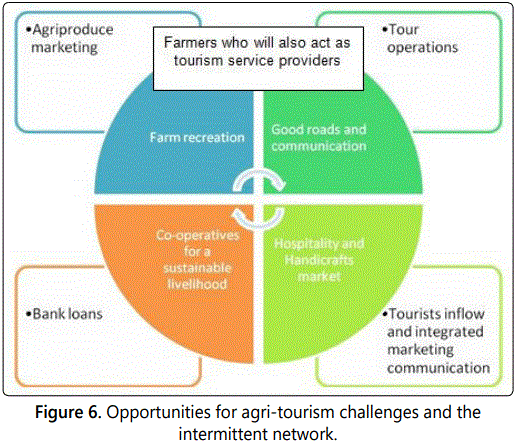
Expected Results and Conclusion
The framework to be developed shall give the farmers a scope to adhere to the check points needed for their farms, its infrastructure, accommodation facilities, maintenance and marketing of farm produces as a value based network. The framework shall throw light on how tourists shall be integral in the agri-tourism concept and implementation of its practices not specific to any urban or rural setting for a farm as shown in figure 7. The stakeholders like the villagers who would be integral to the care and maintenance of the tourist spots and their benefits would also be developed. The farm produces should not just be any product that a tourist buys as a memento for the visit to the farm but also hold the key to this additional source of income. With the advent of cost effective and better farm practices and meeting the demands of the consumers cum tourists this concept of agri-tourism or farm tourism look to be a wholesome package. In agri-tourism, the creators of the project would also like to introduce the younger generation to the various aspects of agriculture including grains, fruits, vegetables, poultry, fishing and dairy especially considering that they have no exposure to the ground level work that goes into the making of things like the bread they eat daily or the milk they drink. In Malhara hills near Nagpur an organic farmer named SubhashPalekar has successfully built the above network of agritourism. Over 5 lakh trees have been planted and they will further propagate, naturally. This large number is necessary to combat greenhouse-gases especially as they would also have a dairy. Trees planted here are fruit-bearing ones like the mango, chiku, guava, cherry, bananas, papayas, custard-apple, coconut, figs, bear, lemon, pear, musambi, jamun, karaonda, aawala, walnut, grapes, supari cherry, kokum, avocado, kaju, leechees, dates, chakotara, mulberry, kavat, etc. All this and more have been planted on an experimental basis in an effort to see what this soil will reject/retain so that eventually the local people could benefit from this experiment and take up planting such species individually and earn profits. Over 500 Mahua saplings have been planted as also sandalwood and teak, and everything is done the ‘natural’ way. Mahua being the Tree of Life of the tribal people, its numerous uses would also be looked into for local benefit.
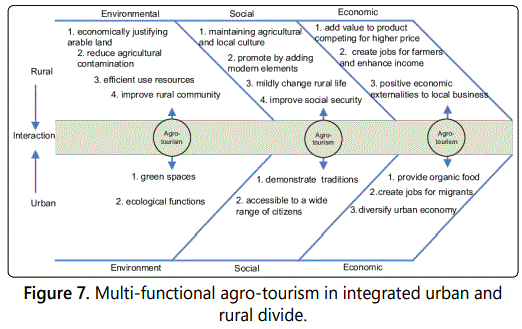
Apart from agriculture, mainly horticulture at this point of time, they intend to work on dairying, not just as in milk production but in the production of manure and they already have a very huge bio-gas plant for which they need the dung from 50 cows. However, this project would take a little time as leaving the cows free could harm the trees planted here. Once the fruiting trees bloom, several bird species would make this their home and the place will be replete with sightings and the calls, twittering and chirps of different avian species. The flowers are already inviting several species of insects hence, apart from being a bird-paradise, it would be of tremendous interest to the entomologist. There is already a designated butterfly park with specific plants to attract butterflies which would be a delight to the lepidopterist. In time, this park is sure to increase footfalls; Nelson Roderigues, well-known lepidopterist from Mumbai, who visits here, vouches that the place has good potential. As for fauna, there are already 15-25 peacocks, wild boar, jackals, deer which are exciting chance sightings. Once the trees grow and the jungles become dense with undergrowth, more animals will come in, besides, the environment would become more conducive for the existing faunal populations to grow. A nature trail walk-way of 7 km with breaks at every 500 meters can be an exciting walk amid the teak and other trees and fields with a colourful medley of flowers, and fields and fields of orange cosmos blossoms. They have planted over 15000 flowering plants this year itself. To prevent rain-water run-off, 4 lakes i.e. catchment areas, have been created in the low-lying areas and a small dam would be constructed between two hillocks. These areas would be used to advantage for bird-watching, adventure sports, angling and could make excellent camping sites. Angling is already being done in a water-body here where Rohu fish have been left to spawn. To start with, two Gypsies would take the tourists around this private jungle premises and on a downhill trek through the lovely natural winding road overlooking the valley with the river in the gorge, with a stopover at the butterfly park en route. Machans over-looking the waterholes are already being constructed which may be very rewardingly used at dawn and dusk for sighting avian activity as well as sighting animals that would come there to quench their thirst like the deer, jackals, wild-boars, and other smaller animals, all of who have already made this their natural habitat. Malhara Hills particularly boasts of quails and partridges and as the fruiting trees come up other birds will become local residents. Doublestoreyed mud houses would do adequately for the naturopathy centre, which are to be built with guidance from an architect from Goa, winner of the “Earth Award” for ecological construction. To keep the atmosphere pollution-free an effort is being made to fully develop the place in a manner conducive to the environment. In keeping with this view they would avoid the use of plastic and encourage the re-introduction of old-world eco-friendly things like the ‘kullhar’ for drinking cups as the soil here is very good. This would also give the villagers a profitable occupation. They would be using all recycled or reused materials. Very importantly, they would concentrate on eco-friendly power supply–solar and gas (biogas) and they already have a huge biogas plant here and will also go in for hybrid wind-mills, a concept still to become popular in these regions. Such boosting examples can definitely lead to a better world and a better life. The crux of all eco-tourism initiatives is the involvement of the local communities and employment opportunities that can accrue to them from this initiative. A boundary of bamboo is being created with a twofold purpose– one, to demarcate their land; two, so that the villagers can use the bamboo for crafts and sell them here and outside. They would keep these bamboo products low-cost so that they can find buyers easily. Even now, most of the workers are local with 40% of them tribal people. They would get trainers from the Bamboo Research Institute in Bangalore to train the villagers here in the creation of artifacts from bamboo and sell these at reasonable prices. They could also use their agricultural produce in the resort. Once this place is fully functional, obviously a plethora of opportunities would open up for the local communities. With reference to the diagram (Figure 7) a special mention should be made for the new definition of agritourism. The probable impacts as in figure 3 shall give an idea to the farmers as to how the concept can be used. The role to be played by the marketers to woo tourists is defined in figure 6. As Mahaliyanaracchi [23] proposes Agri-tourism is a direct marketing activity which provides additional opportunities to farmers to reduce risks involved in farming activities via diversification in a competing and urbanizing economic environment. While farmers get separate income from agritourism products they sell to the visitors, develop own identity they are more riskless than expecting income from one operation that is merely farming.
References